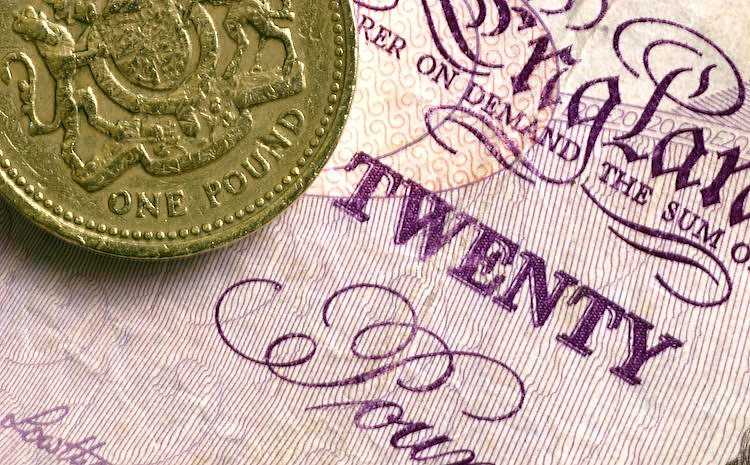Pound Sterling rises as US Dollar drops ahead of Fed's policy decision
- The Pound Sterling rises to a two-week high near 1.2550 amid an improved market mood.
- Investors see the BoE pivoting to interest rate cuts in the June or August meeting.
- The Fed’s policy decision on Wednesday and the NFP report on Friday will be the key events this week.

The Pound Sterling (GBP) hits a fresh two-week high against the US Dollar (USD) near 1.2550 in Monday’s early American session. The GBP/USD pair advances due to cheerful market sentiment and a decline in the US Dollar. The Cable strengthens as mixed guidance from Bank of England (BoE) policymakers over the inflation outlook increases uncertainty about when the BoE will start its interest rate cuts cycle.
BoE Deputy Governor Dave Ramsden said in mid-April that the risks of inflation remaining elevated have receded. Ramsden predicted headline inflation would return to the 2% target in May and said it would likely remain at this level for the next two years.
On the contrary, a few other BoE policymakers, such as Chief Economist Huw Pill, Jonathan Haskel, and Catherine Mann, aren’t that optimistic about the inflation outlook. Most of them have referred to the core Consumer Price Index (CPI) as the preferred measure for decision-making on interest rates, which is still high due to stubborn service inflation. Last week, Pill said: “Time for cutting bank rate remains some way off.”
Financial markets are expecting that the BoE will pivot to rate cuts in the June or August meeting. "It is between June and August, and we are leaning slightly towards August on the basis that one of the key things the BoE is looking at is service inflation," said James Smith, an economist at ING Financial Markets. "If services inflation is a little bit stickier, I think that tilts the balance a little bit further towards August over June, but it's a pretty close call, to be honest", he added.
Daily digest market movers: Pound Sterling exhibits strength ahead of US data-packed week
- The Pound Sterling rallies to 1.2550, capitalizing on improved market sentiment. S&P 500 futures have posted significant gains during the Asian session, suggesting an improvement in investors’ risk appetite. A slight decline in the US Dollar ahead of the Federal Reserve’s interest rate decision has also boosted the GBP/USD pair. However, firm expectations that the Fed will maintain the hawkish tone could support the US Dollar.
- The Fed is widely anticipated to hold interest rates steady in the range of 5.25%- 5.50% in its monetary policy meeting on Wednesday. Fed policymakers are expected to remain data-dependent for further decisions. The central bank will likely reiterate the need to gain more confidence before pivoting to rate cuts.
- A recent batch of consumer inflation data has not offered any relief to Fed policymakers. The United States core Personal Consumption Expenditure Price Index (PCE) data for March, released on Friday, indicated that higher service prices kept price pressures hotter than expected.
- Annually, the core PCE inflation data rose by 2.8%, higher than expectations of 2.6% and at the same pace as in February. The monthly inflation data grew parallel with the consensus and the prior release of 0.3%. The 0.3% growth in monthly core PCE is higher than needed for inflation to return to the desired rate of 2%.
- Apart from the Fed’s monetary policy decision, investors will also focus on the Institute for Supply Management (ISM) Manufacturing Purchasing Managers Index (PMI) data for April, which will be published on Wednesday. The ISM Manufacturing PMI is estimated to remain above the 50.0 threshold, which separates expansion from contraction. The factory data is seen at 50.1, lower than the prior reading of 50.3. The PMI survey by S&P Global for the same period showed a sharp decline in the scale of production and new orders due to inflationary pressures, weak demand and sufficient stock holdings at customers.
- Later this week, the US Nonfarm Payrolls (NFP) data will be the crucial event that will indicate the current status of the labor market.
Technical Analysis: Pound Sterling jumps above 1.2500
The Pound Sterling recovers losses registered in the last weeks and hovers near the neckline of the Head and Shoulder chart pattern. The neckline of the above-mentioned pattern is plotted from December 8 low around 1.2500.
The GBP/USD pair attempts to sustain above the 20-day Exponential Moving Average (EMA), at around 1.2510. The 200-day EMA, at 1.2550, is acting as a major barrier for the Pound Sterling bulls.
The 14-period Relative Strength Index (RSI) shifts into the 40.00-60.00 range, suggesting a consolidation ahead.
Risk sentiment FAQs
In the world of financial jargon the two widely used terms “risk-on” and “risk off'' refer to the level of risk that investors are willing to stomach during the period referenced. In a “risk-on” market, investors are optimistic about the future and more willing to buy risky assets. In a “risk-off” market investors start to ‘play it safe’ because they are worried about the future, and therefore buy less risky assets that are more certain of bringing a return, even if it is relatively modest.
Typically, during periods of “risk-on”, stock markets will rise, most commodities – except Gold – will also gain in value, since they benefit from a positive growth outlook. The currencies of nations that are heavy commodity exporters strengthen because of increased demand, and Cryptocurrencies rise. In a “risk-off” market, Bonds go up – especially major government Bonds – Gold shines, and safe-haven currencies such as the Japanese Yen, Swiss Franc and US Dollar all benefit.
The Australian Dollar (AUD), the Canadian Dollar (CAD), the New Zealand Dollar (NZD) and minor FX like the Ruble (RUB) and the South African Rand (ZAR), all tend to rise in markets that are “risk-on”. This is because the economies of these currencies are heavily reliant on commodity exports for growth, and commodities tend to rise in price during risk-on periods. This is because investors foresee greater demand for raw materials in the future due to heightened economic activity.
The major currencies that tend to rise during periods of “risk-off” are the US Dollar (USD), the Japanese Yen (JPY) and the Swiss Franc (CHF). The US Dollar, because it is the world’s reserve currency, and because in times of crisis investors buy US government debt, which is seen as safe because the largest economy in the world is unlikely to default. The Yen, from increased demand for Japanese government bonds, because a high proportion are held by domestic investors who are unlikely to dump them – even in a crisis. The Swiss Franc, because strict Swiss banking laws offer investors enhanced capital protection.
Author

Sagar Dua
FXStreet
Sagar Dua is associated with the financial markets from his college days. Along with pursuing post-graduation in Commerce in 2014, he started his markets training with chart analysis.


















